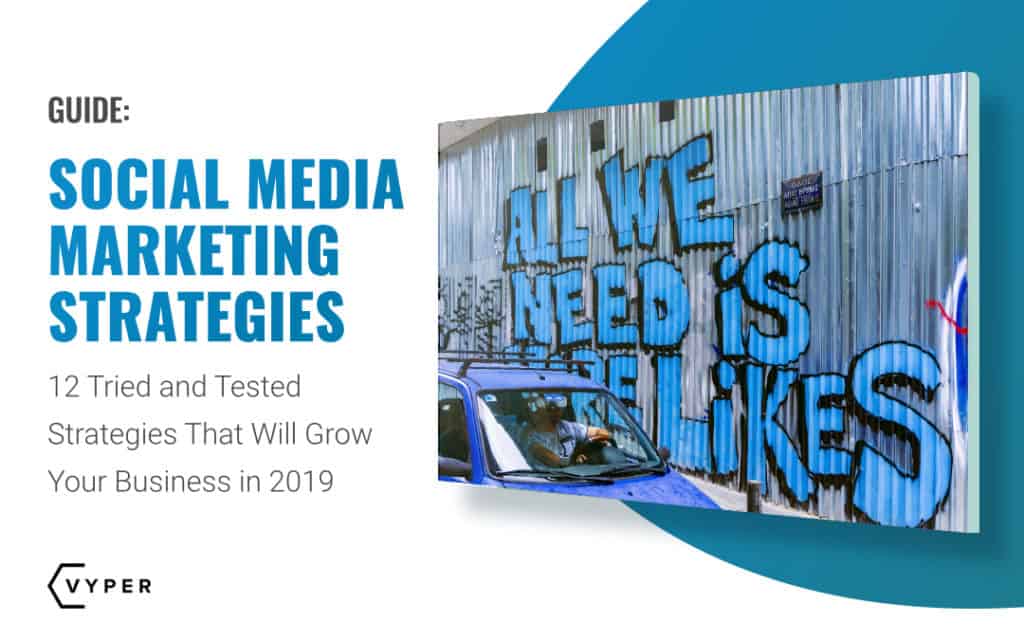Are you on social media? What are the best social media marketing strategies for your business?
Well, you might be on social media but aren’t sure what strategy to adopt. And in this article, we will share the 12 best social media marketing strategies that are proved to be effective. There are the latest techniques that are currently generating impressive results for other businesses and will likely continue to be used in the future.
As more businesses are getting into social media, obtaining results continues to get more difficult. Currently, there are more than 3.48 billion social media users. Facebook is the most popular social networking site with over 2.32 billion active monthly users, followed by YouTube (1.9 billion), and Instagram that taking the third position with 1 billion active users.
Besides, 63% of consumers expect businesses to offer customer support through their social media channels, when 90% of customers already use social media to engage with businesses, according to Smart Insights. If you are not on social media, you are not doing any favor to your business.
Although achieving noticeable results on social media is getting more complex by the day, adopting the right strategies can make you stand out and reach your target market.
So below are the twelve tried, tested, and efficient social media marketing strategies that will grow your business in 2019. In the end, we will talk about a few effective social media marketing tools to help you achieve your desired results.
Let’s get started.

Social Media Marketing Strategies Table of Contents
- Set Clear, Relevant, and Realistic Social Media Marketing Goals
- Know Your Target Social Media Customers
- Determine your Most Relevant Social Metrics
- “Steal” Ideas from Your Competitors
- Monitor Your Customers and Competitors on Social Media
- Create Content that Your Target Audience Wants to Consume
- Keep Your Audience Engaged
- Choose One or Two Social Channels and Grow from There
- Have a Content Calendar
- Assess the Results
- Talk to Your Audience One-on-One
- Encourage Employee Advocacy
1. Set Clear, Relevant, and Realistic Social Media Marketing Goals

And this is where most businesses fail. While many businesses are engaged in social media, only a few spend the time to set realistic social media marketing goals. Many don’t know why they are on social media or even if they know, they don’t know where to get started.
So the first thing to do is to figure out what you want to achieve on social media. This is the time you set strategies for your business growth. Of course, your social goals must be achievable.
For instance, planning to achieve 1 million Instagram followers in 2019 is like shooting in the dark. So you need to set small, realistic, and attainable goals. Once you set them, you will be able to know the budget and which social media channel to use.
Set SMART Goals
Oftentimes, business owners set vague goals that are why even when you ask them about their goals, they can’t tell you anything clear about them.
One thing you need to know is that you are setting social media goals to achieve something and not for the sake of it. You do it so you can identify what social media strategy to adopt to scale your business.
For that reason, set SMART goals that are Quantifiable, Precise, Achievable, Relevant, Time-bound. They will increase the likelihood of attaining them. You will also be able to track your progress. Of course, you should challenge yourself, but it’s important to set achievable goals.
Also, understand that you cannot be successful on every social media channel. Figure out the social network that your target market spends their time and stick to it.
Some actionable social media goals you could set include:
Increase your reach: Your goal could be to create brand awareness. Make your business known to many people. For that reason, avoid sending too many promotional messages to your target customers. Concentrate on sharing content that helps your target customers and is not just about selling.
Improve the quality of sales: Of course, you will need to engage with your target customers by sharing amazing content, but the end goal is to convince them to purchase your offers.
Attracting in-store sales: If you have a “brick-and-mortar” business, you would set the goal to engage more customers to come to your store and purchase the products you sell. Let your customers know what you do in your store.
Improve ROI: You don’t want to spend more money than you get from social media. Positive social media ROI isn’t something you can achieve overnight. You need to do a thorough assessment of the social network you are using so that you know how much you can spend and the returns you will get.
Increase your following: Your customers are your brand ambassadors. You need to find out the content they consume the most and give them exactly that and then encourage them to share this content with others on your behalf.
2. Know Your Target Social Media Customers
Many marketers have failed because they assume that all social media networks are great for them.
You must understand that social media users are different. People use social media differently. While some will use Facebook to learn more about a particular brand, some will use it to interact, connect and stay in touch with friends, family, and colleagues.
For that reason, you must make sure to use a channel in which your target customers spend most of their time. And if you are going to use influencer marketing, ensure the influencers you partner with, have an audience like yours. Any mismatch can cause harm to your business.
First of all, check into your social media marketing goals. Figure out the social network that can help you achieve those goals. Get to know your customers, their habits on social media, etc. The more information you have about your social media audience, the better you will engage with them.
The good thing is that understanding your customer base these days has been made simple, especially, with the availability of a huge wealth of demographic insights and social media analytics tools. No guesswork anymore.
3. Determine your Most Relevant Social Metrics
This is also another area many businesses fail. So you have attracted huge followership, your business is known to many people, what next? Do you just pump in resources on your social accounts without figuring out what’s working?
Unfortunately, many businesses fail to track their social analytics and because different businesses have different analytics, many marketers find themselves on a crossroads.
Remember, your social media strategy must be based on data. That means concentrating on your most relevant social media metrics that align with your social media goals.
You might have hundreds of thousands or even millions of followers and plenty of likes, and shares, but if you are not making sales, they all mean nothing. Do you need millions of followers who aren’t engaging with your content? NO!
You’d better have one thousand followers who are engaging with your business and possibly buying from you. In fact, the idea of buying Instagram followers that most people use is just killing their businesses silently.
Take a look at some of 2019’s most engaging Instagram campaigns if you are looking for a little inspiration.
Determining engagement metrics can help you build a lasting relationship with your target audience.
To figure out which metrics will provide you with insights into whether you are achieving your goals, check the goals you have set.
Examples of metrics you should determine to include:
Clicks- What type of content is getting more clicks? Tracking your link clicks will help you know the journey users take through your marketing funnel.
Post reach- How many people check on your posts? Is your content reaching a wider audience? Monitoring your post reach is important, especially in today’s world where algorithms are changing each day.
Engagement– How is your target audience engaging with your content? Who are they; women or men; young or old? Gathering all this information will help you to know how your audience sees you.
Hashtag performance– This is a measure of the number of #hashtags that created a buzz. There is no need of using too many hashtags that are creating engagement.

4. “Steal” Ideas from Your Competitors
They say “no man is an island” and as a business, you can’t operate in seclusion.
These days, no business lacks competition. Chances are that the strategy you are about to execute has already been executed by your business rivalry.
The best place to start with is to investigate how your competitors are approaching social media. Find out what they are doing on social media. Where do they put much focus on? Who are their target audiences? What search terms are they dominating?
Here, you will need to do some competitor analysis. For that reason, you will need to work with competitor analysis tools to explore your competitors. By digging deep into your competitors, you will be able to come up with a powerful social media strategy; you will also understand what content your target market in your industry expects from.
Digging deep into your competitors might also help you to find gaps you can fill. For instance, your potential competitors might be vibrant on Facebook, but less active on Instagram or Twitter so possibly you can have a good audience on the last two platforms.
You can then decide to outsmart your competitors by directing more resources on Twitter and Instagram instead of competing with them on Facebook.
There are plenty of tools to spy your competitors as you will read toward the end of this article.
5. Monitor Your Customers and Competitors on Social Media
If there is one favor you can do for your business when it comes to marketing, it will be to work with data. Gathering useful data will help you increase the chances of succeeding in marketing. For that reason, you need to know who you are engaging with, what your competitors are doing, and where you want to reach.
Equipped with this knowledge, you can adjust, improve or change your marketing decisions to create effective social media marketing strategies.
Additionally, integrating powerful knowledge management tools into your toolkit enables you to track conversations, conduct market research, and gain deep insights into your target market’s preferences and behaviors across various social media channels.
So how do you gather all this data for your social media strategy?
It’s simple; listen to your customers and competitors by use of a social listening tool.
You need to track useful conversations happening on the internet. So you will need a tool that will allow you to achieve right that. The tool must be powerful in that it can help you track various terms used by customers and competitors on various social media channels, conduct market research, and also equip you with knowledge about your target market.
6. Create Content that Your Target Audience Wants to Consume

Content is still king. However, to achieve your social media goals, you need to share high-quality content that your target audience will want to consume, like, and share with their friends as well.
Unfortunately, many businesses fail because of sharing overly promotional content with their audience. 46% of social media users will unfollow a brand that shares overly promotional material and 41% will unfollow a brand that shares content that doesn’t meet their interests.
Besides, social media channels are also penalizing promotional content. After all, social media networks are for socialization purposes and not places to sell products or services.
For that reason, you must share content that’s balanced – content that’s informative, entertaining, but has a little bit of promotional material. If you are getting into social media solely for selling, you won’t make any sales.
You must keep your target audience engaged by sharing helpful and meaningful content, like, share and comment on other people’s content. And since you’ve already established the networks to focus on and you have defined your social goals your next step is to create content that meets your target audiences’ interests.
To help you narrow down on the specifics of what content to create, ask yourself these few questions:
- What are the minimum/maximum characters for each social media network?
- How much #hashtags are enough on each channel?
- Should you integrate emojis when sending social messages?
- What’s the suitable content for each network?
Having addressed that below is the type of content you can share with your target audience.
Video content- Video is the most viewed and shared content across all networks. Users are 40 times more likely to share video content on social media than text or any other type of content. Instagram and Facebook to be specific are the most popular social media networks where video content is working wonders. Besides, 64 percent of customers say they are more likely to buy a product on the internet that has a video demonstration.
The good thing is that you can share long-form and live videos of Facebook and short looping video on Instagram.
UGC aka User-generated content– You don’t have to produce professional or polished content always. You can curate user-generated content for your target audience. Besides, curating UGC content doesn’t entail too much effort.
7. Keep Your Audience Engaged
Don’t make your social media channels ghost towns.
When people come to your channel they aren’t there to read what you have published or watch the videos you have shared. Social media is a platform designed for interacting with others. You need to engage with your prospects. Just take a look at the most successful businesses out there and you will see how active they are when it comes to engaging with their audiences.
Unfortunately, if you made a mistake to cover every social platform on earth and you don’t have sufficient personal, then you will fail to engage with your followers.
And this takes us to the next social media strategy which is:
8. Choose One or Two Social Channels and Grow from There
Many marketers fail because they want to be omnipresent. They want to be found on every social platform on earth. When you are just getting started creating your brand awareness on social media, you could think that being found on Facebook, Twitter, Instagram, YouTube, Snapchat and many other platforms can increase your chances of success but this isn’t true.
9. Have a Content Calendar
Timeliness is key when it comes to sharing the content on your social media channels.
These days, social media platforms have algorithms to filter the content to be shown on people’s news feed. So you have to post at the time when your target audience is active on social media so that they can see and engage with your content.
To make work easier, you could use social media posting and scheduling tools- we will cover these tools at the end of this post.
These tools will make your life easier.
People have different opinions over how many posts you can share on each social platform and the best time to post. Check the report by Coschedule that shows the best times to post on social media.
10. Assess the Results
Sometimes even after giving your social media marketing strategies all your efforts, you might not achieve the results you expected. You need to know what’s working, what’s not working, and where you need to improve. This way, you will know whether your social campaigns are successful or not.
Since you started your journey by defining your social goals and establishing metrics that matter to you, you need to monitor those metrics to see whether there is progress or not. Do you see a positive effect on your metrics?
If your content does not engage with your audience, find out how you can fine-tune it. You could also ask your audience what content they want you to deliver.
11. Talk to Your Audience One-on-One
This is sometimes known as conversational marketing where you reach out to your target audience in person. This is an approach that can help you understand your prospects better and improve your conversions tremendously.
This social marketing strategy focuses on human connection.
Note that social media is a place to interact and social with your target audience. Once your readers have landed on your website, you shouldn’t end the conversation there.
That’s where Drift comes in. Drift is a powerful tool used for conversational marketing. You can integrate it on your website so that you can keep your target customers engaged when they come to your site.
12. Encourage Employee Advocacy
Last but not least, you can encourage your employees to promote your company’s message. Well, this strategy is suitable for boosting brand awareness and results.
Note that you might have huge followership that can’t beat the smaller audience your employee has when it comes to engagement.
You can ask your employees to share your brand messages with their followers and this can increase your reach, website traffic and boost social media engagement.
13. Must-Have Social Media Marketing Tools for 2019
Now that you have learned the social media marketing strategies you should use in 2019, here are tools to help you in the implementation of those strategies.
Remember, social media marketing may look easy but can be challenging to make it work for you if you don’t have the resources, personnel and the right tools for the job.
Below are some powerful tools that will help you in any or all of the following tasks:
- Social media marketing management
- Social media monitoring and tracking
- Post scheduling
- Curating of content (video, audio, infographics, images, etc.)
- Social media listening
- Reviewing analytics
- Managing an editorial calendar and many other tasks.
These tools will help you implement an effective social strategy that will see 71% of shoppers recommending your brands to others for the good experience they will have on your social media channel.
These tools are easy to use (suitable for beginners and experts alike) and some of them offer a 30-days trial period.
Let’s keep going
Buffer

Buffer was originally introduced as a Twitter scheduling tool. These days, it is one of the most powerful post scheduling tools on all popular social networks including Instagram, Facebook, LinkedIn, etc. With this tool, you can schedule posts to go live across a variety of social media networks all in one place.
Besides, the tool allows you to create specific posts for specific social media channels and you can share similar content on all your social media accounts.
This social media marketing tool helps to make sure your posts go live at the time when your target audiences are active on their preferred channels.
The good thing about Buffer is that it’s not costly and its user interface is straightforward.
Buzzsumo

As you have read above, when determining your best social media marketing you should spy on your potential customers and competitors. It’s impossible to achieve that without the right tool.
That’s where Buffer comes in. This is a powerful tool to help you dig deep on your competitors, find out what they are doing, who their target market is, and in which social media channels they are engaging their audience.
The tool will also let you know the performance of your content and people who are interacting and sharing it. Buffer is perhaps one of the most powerful social media research tools since it helps you to:
- Discover buzz-worthy content on social media platforms; both yours and other people’s content.
- Discover influencers in your niche and other niches
- Receive alerts based on search terms, links, etc.
- Monitor competitors and analyze the performance of their content
- You can also use Buzzsumo to discover trending topics your audiences want to consume.
MeetEdgar

As a marketer, you have many hats to wear. And if you are just a startup, you might not have the budget to hire a team of professionals to take care of content creation, scheduling, etc.
MeetEdgar is a powerful social scheduling tool that allows old posts re-sharing as well as optimizing your social traffic. You can call it a powerful automated content manager.
Remember, no matter how good or popular your content is it will soon be forgotten. This tool will help in recycling your old posts and hence attract new views.
Hootsuite

Undeniably, most companies have more than 2 social media accounts and managing them manually can be challenging. With Hootsuite, you can handle multiple social media tasks under a centralized dashboard. This makes your post scheduling and social media management effortless.
Another good thing about this tool is that you can see all engagement across multiple channels in one place. Besides, you can integrate it with the most popular social networks such as Facebook, Instagram, Twitter, YouTube, and Google+ so you can view all your analytics in one place.
Mention

To build a strong social media presence, you must listen to customers and potential competitors. You need to know who mentions your brand, your products, and your competitors. Mention is a suitable tool to help you monitor such things.
The tool allows you to set alerts so you get a notification every time your brand is mentioned. Furthermore, you can also respond to each mention, tag, share, like, comments from inside the tool. You can also use the tool to find influencers for influencer marketing campaigns.
Sprout Social

Sprout Social is a complete social media management tool that helps to publish, engage, collaborate with tools, and get analytics. With this tool, you can discover, build, and strengthen your relationship with your target market.
Bitly

Sometimes you will want to share links with your followers on social media. As such, you don’t want to share links that are too long or too complicated to remember. Bitly is a powerful free link Shortener. Copy the link you want to be shortened on Bitly, and the tool will do the shortening automatically.
Short URLs are clean and memorable, lengthy ones are tricky to share, complicated and are not memorable. This tool will help to make everything simple.
Besides, Bitly does not only take care of your link shortening tasks, but it can also work as a campaign tracking tool. With this tool, you can tell who clicked on your links, when, and on which social platform.
AddThis

Even the best and high-quality content won’t get you the results you expect if no one is reading and sharing it. After all, we all struggle to create amazing content that other people would like to read and share. AddThis is a powerful tool that features social share buttons which allows your content readers to share your content on their preferred social channels.
You don’t pay anything to use this tool by the way and it allows collaboration of up to more than 200 social networks worldwide.
IFTTT

IFTTT means If This, Then That and this implies that after creating your social media posts and scheduling them the next step that follows is to automate your tasks. With this tool, you can create a blog post and then create an IFTTT schedule for it so that the tool can view the post, make a tweet and Instagram post and publish it.
The tool allows you to set rules that trigger a specific action when something happens. For instance, you can set a rule that when you get a specific alert it is added to your Google doc automatically so you can check it later.
Tailwind

You must have come across this tool if you are a Pinterest fan. But if not, then understand that Tailwind is a powerful social media marketing tool for users who like visual content, especially for Instagrammers and Pinners. With this tool, you can find amazing content, automate posts, track mentions, maximize your reach, and also evaluate results.
Tweepi

Our last social media marketing tool is Tweepi. This is a tool for Twitter users. It helps to increase brand awareness on Twitter. The tool allows users to maximize followers quickly.
Social media marketing tools provide an amazing experience when it comes to promoting your company or business on social media networks. These are just a few of the most powerful tools but you can find many others out there.
Wrapping it Up
Are your social media marketing strategies bringing the results you expect?
There are limitless social media marketing techniques you can implement to help you increase the chances of success on social media. Try to experiment with one, two, three or a mixture of these social strategies, assess the results and see what works and what isn’t working.
Did we miss any of your social media marketing strategies? Let us hear that in the comment section.
Good Luck!
Author bio
Sandra Dufrene is a freelance writer and an editor at top dissertation writing services. She has a keen interest in photography and dedicates all her free time to it. Sandra has extensive knowledge in different fields such as marketing, education, and blogging. You can contact her on Twitter.
Jack Paxton is the co-founder of VYPER, a marketing tool that helps brands build email lists, social followings, and revenue using viral giveaways, referral, and reward programs. After millions of dollars spent testing different marketing strategies at his marketing agency. He then also co-founded Hyax a fast, conversion & design-focused course and funnel builder for creators.




Trackbacks/Pingbacks